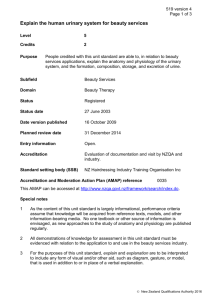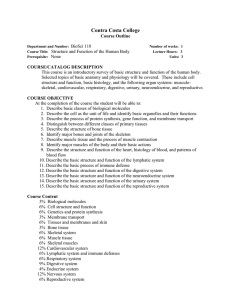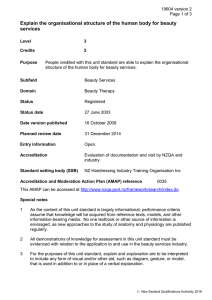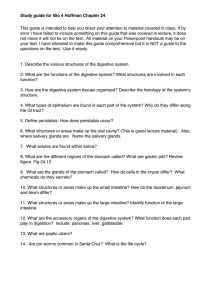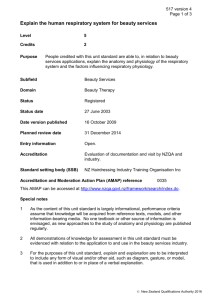Explain the human digestive system for beauty services
advertisement
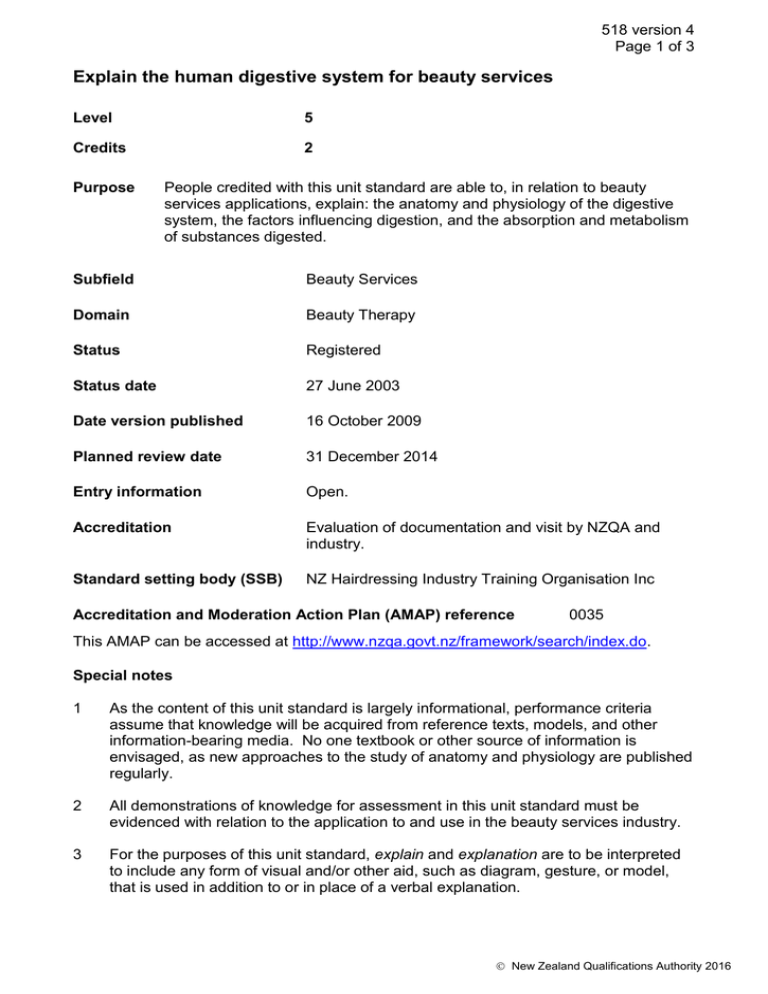
518 version 4 Page 1 of 3 Explain the human digestive system for beauty services Level 5 Credits 2 Purpose People credited with this unit standard are able to, in relation to beauty services applications, explain: the anatomy and physiology of the digestive system, the factors influencing digestion, and the absorption and metabolism of substances digested. Subfield Beauty Services Domain Beauty Therapy Status Registered Status date 27 June 2003 Date version published 16 October 2009 Planned review date 31 December 2014 Entry information Open. Accreditation Evaluation of documentation and visit by NZQA and industry. Standard setting body (SSB) NZ Hairdressing Industry Training Organisation Inc Accreditation and Moderation Action Plan (AMAP) reference 0035 This AMAP can be accessed at http://www.nzqa.govt.nz/framework/search/index.do. Special notes 1 As the content of this unit standard is largely informational, performance criteria assume that knowledge will be acquired from reference texts, models, and other information-bearing media. No one textbook or other source of information is envisaged, as new approaches to the study of anatomy and physiology are published regularly. 2 All demonstrations of knowledge for assessment in this unit standard must be evidenced with relation to the application to and use in the beauty services industry. 3 For the purposes of this unit standard, explain and explanation are to be interpreted to include any form of visual and/or other aid, such as diagram, gesture, or model, that is used in addition to or in place of a verbal explanation. New Zealand Qualifications Authority 2016 518 version 4 Page 2 of 3 4 In this unit standard, all ranges identify the minimum that is critical for assessment. A wider scope may nevertheless be taught. 5 The focus of this unit standard is the anatomy and physiology of human systems that are healthy and functioning properly. Diseases and disorders are included only where appropriate to the professional competence of a beauty practitioner. Elements and performance criteria Element 1 Explain the anatomy and physiology of the digestive system. Range mouth, pharynx, oesophagus, stomach, small intestine, large intestine, pancreas, liver, gall bladder, rectum, anus. Performance criteria 1.1 Explanation describes the anatomy of the component parts of the digestive system. Range 1.2 location, composition. Explanation describes the physiology of the component parts of the digestive system. Range ingestion, digestion, absorption, elimination. Element 2 Explain the factors influencing digestion. Performance criteria 2.1 Explanation describes salivary secretion, gastric secretion, pancreatic secretion, bile secretion, and small intestinal secretion. Range enzyme production, presence and composition of food in digestive tract. 2.2 Explanation describes the action of digestive enzymes in relation to the breakdown of proteins, carbohydrates, and fats. 2.3 Explanation describes the mechanical movements of the gastrointestinal tract in relation to the movement of food through the digestive tract. Range mastication, churning of food and chyme, peristalsis, relaxation of sphincters. New Zealand Qualifications Authority 2016 518 version 4 Page 3 of 3 Element 3 Explain the absorption and metabolism of substances digested. Range water, carbohydrates, lipids, proteins, alcohol, drugs, vitamins, minerals. Performance criteria 3.1 Explanation describes the absorption of substances in relation to their position in the digestive tract. Range absorption in – mouth, stomach, small intestine, large intestine, rectum. Please note Providers must be accredited by NZQA, or an inter-institutional body with delegated authority for quality assurance, before they can report credits from assessment against unit standards or deliver courses of study leading to that assessment. Industry Training Organisations must be accredited by NZQA before they can register credits from assessment against unit standards. Accredited providers and Industry Training Organisations assessing against unit standards must engage with the moderation system that applies to those standards. Accreditation requirements and an outline of the moderation system that applies to this standard are outlined in the Accreditation and Moderation Action Plan (AMAP). The AMAP also includes useful information about special requirements for organisations wishing to develop education and training programmes, such as minimum qualifications for tutors and assessors, and special resource requirements. Comments on this unit standard Please contact the NZ Hairdressing Industry Training Organisation Inc enquiries@hito.org.nz if you wish to suggest changes to the content of this unit standard. New Zealand Qualifications Authority 2016
